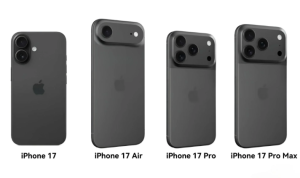Finding the right smartphone can be a bottleneck for productivity, especially when you're pushing the boundaries of technology. Developers and tech enthusiasts need devices that are not just powerful, but also flexible and future-proof.
What You'll Learn:
- The evolving role of smartphones for advanced users in 2025.
- Key smartphone features that matter most for development and tech exploration.
- Our curated list of the top 5 smartphones for 2025, balancing premium and value.
- A practical framework for selecting the perfect device for your specific needs.
Part 2: Main Body
Why Smartphones for Advanced Tech Matters in 2025
In 2025, the smartphone has transcended its role as a mere communication tool. For developers and advanced tech enthusiasts, it's a portable workstation, a testing ground, and a gateway to cutting-edge experiences. The lines between mobile and desktop are blurring, making the smartphone an indispensable part of the modern tech workflow.
Current Market Trends
The market in 2025 is characterized by several key trends that directly impact advanced users:
- On-Device AI and Machine Learning: Processors are becoming increasingly powerful, enabling complex AI tasks to be performed directly on the device, reducing latency and enhancing privacy. This is crucial for developers experimenting with mobile AI applications.
- Enhanced Connectivity: 5G is now ubiquitous, and the groundwork for 6G is being laid, offering unparalleled speeds and lower latency, which is vital for cloud-based development and real-time testing.
- Foldable and Flexible Displays: While still premium, these devices offer larger screen real estate and innovative form factors, providing new opportunities for app design and multitasking.
- Sustainability and Repairability: Growing consumer awareness is pushing manufacturers to adopt more sustainable practices and design devices that are easier to repair, a point of interest for environmentally conscious tech users.
Future Outlook
The future of smartphones for advanced users points towards greater autonomy and integration. We can expect:
- More Powerful Mobile Computing: Devices will increasingly rival laptops in processing power, enabling more sophisticated development tasks directly on the phone.
- Seamless Ecosystem Integration: Deeper integration with other devices, including AR/VR headsets and smart home systems, will become the norm.
- Specialized Hardware: We might see more devices with hardware tailored for specific tasks, such as dedicated AI accelerators or advanced sensor arrays.
- Open Ecosystems: A continued push for more open operating systems and developer tools will empower users to customize and extend their devices' capabilities.
“The smartphone in 2025 is no longer just an endpoint; it's a dynamic hub for creation and innovation. Developers need devices that can keep pace with their ambition.”
Top Smartphones for Advanced Tech Options
Choosing a smartphone in 2025 involves navigating a landscape of powerful flagships and increasingly capable budget options. Here are our top picks.
Premium Solutions
These devices offer the absolute best in performance, features, and build quality, ideal for those who demand top-tier capabilities.
- Apple iPhone 16 Pro Max: Continues to be a powerhouse with its A-series chip, exceptional build quality, and a robust developer ecosystem. Its Metal graphics API and Swift language support are unparalleled for iOS development. The advanced camera system also aids in visual projects.
- Samsung Galaxy S25 Ultra: Boasts a stunning Dynamic AMOLED display, the latest Snapdragon processor, and the S Pen, making it a versatile tool for note-taking, sketching, and even some coding tasks. Its DeX mode offers a desktop-like experience when connected to an external monitor.
- Google Pixel 9 Pro: Offers a pure Android experience with cutting-edge AI features powered by Google's Tensor chip. Its exceptional camera and seamless integration with Google services make it a favorite for Android developers and those focused on AI research.
Budget-Friendly Alternatives
These devices offer significant value, providing excellent performance and features without the premium price tag, perfect for developers on a budget or those exploring new platforms.
- OnePlus 12: Delivers flagship-level performance with its powerful processor and fast charging capabilities at a more accessible price. Its OxygenOS is known for its clean interface and useful developer options.
- Nothing Phone (3): Continues to impress with its unique design and focus on a clean, bloatware-free Android experience. It offers solid performance and a commitment to regular software updates, making it a reliable choice for tinkerers.
Feature Comparison Table
| Feature | iPhone 16 Pro Max | Samsung Galaxy S25 Ultra | Google Pixel 9 Pro | OnePlus 12 |
Nothing Phone (3)
|
| Processor | A18 Bionic | Snapdragon 8 Gen 4 | Google Tensor G4 | Snapdragon 8 Gen 3 |
Snapdragon 8 Gen 3
|
| Display | 6.7″ Super Retina XDR | 6.8″ Dynamic AMOLED 2X | 6.7″ LTPO OLED | 6.82″ LTPO AMOLED |
6.7″ LTPO OLED
|
| RAM | 8GB | 12GB/16GB | 12GB | 12GB/16GB | 12GB |
| Storage | 256GB – 1TB | 256GB – 1TB | 128GB – 512GB | 256GB/512GB | 128GB/256GB |
| Key Feature | iOS Dev Ecosystem | S Pen, DeX Mode | AI Integration | Fast Charging | |
| Approx. Price | $$$$ | $$$$ | $$$ | $$ | $$ |
How to Choose the Right Smartphone for Advanced Tech
Selecting the ideal device involves aligning its capabilities with your specific needs and workflow.
Selection Criteria
When evaluating smartphones for development and advanced tech use, consider these critical factors:
- Processing Power & RAM: Essential for running emulators, compiling code, and multitasking. Look for the latest flagship chipsets and ample RAM (12GB+ is recommended for heavy use).
- Display Quality & Size: A high-resolution, color-accurate display is crucial for UI/UX design and immersive experiences. Larger screens or foldable options can enhance productivity.
- Storage Capacity: Developers often need significant space for SDKs, project files, and large datasets. Aim for at least 256GB, with 512GB or more being ideal.
- Operating System & Ecosystem: Your choice of OS (iOS or Android) will heavily influence your development environment and available tools. Consider the ecosystem you're most invested in.
- Battery Life & Charging Speed: Long development sessions require a battery that can last. Fast charging is a lifesaver for quick top-ups.
- Connectivity: Support for the latest Wi-Fi standards and 5G/6G is vital for seamless cloud access and testing.
- Developer Options & Customization: Access to advanced developer settings, the ability to unlock the bootloader (for Android), and a flexible OS are key for customization and deep dives.
Decision Framework
To help you make an informed decision, here’s a simple framework:
-
Define Your Primary Use Case:
- Mobile App Development: Focus on the target platform (iOS/Android) and choose accordingly. Consider emulation capabilities and debugging tools.
- AI/ML Experimentation: Prioritize devices with powerful NPUs (Neural Processing Units) and ample RAM.
- Web Development/Cloud Access: Look for strong connectivity, good battery life, and potentially a larger display or desktop-like mode.
- General Tech Exploration: A balanced device with good performance and a flexible OS is key.
-
Prioritize Features: Rank the selection criteria based on your needs. For instance, if you're an iOS developer, the iPhone is likely non-negotiable. If you're an Android developer experimenting with AI, a Pixel might be superior.
-
Set Your Budget: Determine how much you're willing to spend. Premium devices offer the best, but capable budget options can be surprisingly effective.
-
Read Reviews & Benchmarks: Once you've narrowed down your choices, dive deep into detailed reviews and performance benchmarks specifically for developer tasks.
“For developers, the smartphone is a portable IDE. The right device can dramatically accelerate the development cycle.”
FAQ (Frequently Asked Questions)
Q: Can I really develop complex applications on a smartphone in 2025?
A: Yes, with advancements in mobile processors, cloud IDEs (like Termux for Android or CodeSandbox for iOS via browser), and the increasing power of on-device compilation tools, it's becoming increasingly feasible to develop moderately complex applications directly on a smartphone. For very large-scale or resource-intensive projects, it might still be more efficient to use a dedicated computer, but for many tasks, a powerful smartphone is sufficient.
Q: What does “developer options” mean on Android, and why is it important?
A: “Developer options” is a hidden menu on Android devices that unlocks advanced settings not typically available to regular users. For developers, it's crucial as it allows for USB debugging, enabling mock locations, controlling animation speeds, monitoring app performance, and accessing other tools essential for app development and testing.
Q: Is it worth investing in a foldable smartphone for development?
A: Foldable smartphones offer a unique advantage for developers by providing a larger, more versatile screen real estate. This can be beneficial for UI/UX design, multitasking, and testing apps on different screen configurations. However, they come at a premium price and may have durability concerns compared to traditional smartphones. It's worth considering if the increased screen size significantly enhances your workflow.
Q: How important is the operating system for a developer's smartphone choice?
A: The operating system is paramount. If you're developing for iOS, an iPhone is almost essential due to Apple's closed ecosystem and development tools (Xcode). For Android development, while any high-end Android device will work, devices with cleaner interfaces and more accessible developer settings (like Pixels or OnePluses) can offer a smoother experience.








